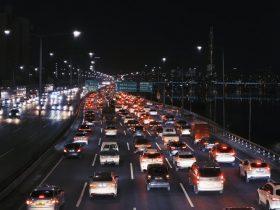The e-hailing industry is expected to develop at a CAGR between 15 to 28 per cent, resulting in an increased market size of $285bn by 2030
If there’s one thing everyone agrees on in the aftermath of the pandemic, it’s that mobility as we know it has irrevocably changed. The transportation industry had already been disrupted by technology before 2020, with ride-hailing apps allowing commuters to have more control over their movements.
However, the pandemic transformed that experience into one of necessity and convenience. Add in the fact that, close to 20 per cent of the global workforce was told to work from home for the foreseeable future in the early months of the pandemic – the overall impact on the transportation sector cannot be understated.
According to a report published by Arthur D. Little in 2020, the lockdown reduced overall mobility demand in the US by up to 90 per cent, with 40-70 per cent reductions persisting during the recovery period. As people attempt to preserve social distance during journeys, this has been accompanied by increased personal mobility (cycling, walking, vehicles).
Before the pandemic, urban mobility demand was expected to expand exponentially, with urbanisation continuing and global demand for passenger mobility in urbanised regions expected to double by 2050 compared to 2010. Research indicates the pandemic had little effect on this growth tendency since the city population continued to expand faster than the overall growth of the global population.
That’s where mobility on demand (MoD) and mobility as a service comes into the spotlight. MoD is a new way of travelling that combines several easily accessible means of transportation to make an individual’s journeys more efficient. MoD is entirely based on technology, enabling people to be better informed of available options and make them more productive with their time.
Private firms, public entities, startups, and mobile apps such as ride-hailing apps and car-share providers, which cut out the middlemen and use independent contractors, provide solutions that facilitate MoD today. MoD dispels the myth that the only efficient way to travel anywhere – whether locally or internationally – is to own a vehicle or pay large sums to rent. The ownership trend is quickly giving way to usership or partnership. With a growing number of environmentally concerned young people entering the workforce and a high reliance on digital assets, MoD provides them the satisfaction of reducing their carbon footprint.
The sharing economy is all about fractionalisation and digitalisation of assets or services. Every sector is undergoing
a digital transformation and re-thinking business and revenue models to engage with more customers regularly. With cars, particularly in the context of car sharing, an ‘illiquid asset’, that is, one that is ordinarily only available to one person is fractionalised through digitalisation into a car that is measured and priced by minute or meter and may be driven by anyone with a license.
Additionally, with ride-hailing industries, the expense or requirement of a license is removed because the customer receives the added benefit of a driver for the customer, allowing for even more micro-mobility access. According to another report by Arthur D. Little, the e-hailing industry is expected to develop at a CAGR between 15 to 28 per cent, resulting in an increased market size of $285bn by 2030. Primary drivers of this growth will be the lower rate of car ownership among millennials and the expected progressive integration of ride-hailing into other solutions, which include car sharing and bike sharing.
In a McKinsey survey of the US, UK, Germany, France, Italy, Japan, and China, it was discovered that key factors related to health and hygiene changed how private and business trips were now chosen. The cost of a trip was no longer as important as staying safe from health hazards. While the world shifts from CAPEX to OPEX and from ownership to usership, the ‘Netflix’ generation in the GCC is more interested in consumption than long-term acquisition. As automobiles become fully autonomous, car sharing, and ride-hailing will merge. Car sharing providers are already developing products to prepare for this, giving them more opportunities to scale horizontally and vertically while also providing an already experienced customer with more options. This will significantly influence the GCC, where young people who want to live aspirational lives are already establishing themselves.
Before the sharing economy, people were unable to engage due to the lack of infrastructure, and the high cost of current modes of transportation. A trip from Deira to Expo 2020 used to cost a minimum of Dhs120, but now only costs Dhs40, thanks to car sharing. And yet, there is still a long way to go.
In the UAE, the car-sharing to passenger car market has a penetration rate of 0.05 per cent. This is a twelve-fold decrease from Tallinn’s (in Estonia) 0.64 per cent and Moscow’s 0.87 per cent. Nonetheless, the UAE is seen as a more digitally savvy populace with higher internet penetration than most countries. The UAE has approximately 1,000 car-sharing cars today, while Moscow has 36,000. According to research conducted by car-sharing companies, the short-term potential is roughly 8,000 vehicles, with a long-term prospect of over 30,000 vehicles over the next five years.
The potential of the mobility market is enormous. The key to growth is an ecosystem approach and technology enablement. Only a business model based on partnerships and scalability can achieve sustainable development. People were previously unable to make trips that could not be completed by walking or cycling due to a lack of a practical mobility alternative. According to European statistics, one car-sharing vehicle replaces 17 cars that would otherwise take up parking spots, waste fuel, and emit carbon.
Finally, technology can help stream-line an experience, changing the dynamics of the business model and revenue/cost streams in the process. The question to consider for newcomers to the market is whether they can generate a million dollars from a million customers or ten customers? Which route is the best option if they can do this with ease and with an excellent interface? One option has a lower risk of losing a customer, but the other has a higher revenue loss. The challenge then is to build a service or platform that can appeal to customers across the market while providing five-star services for everyone.
Nicholas Watson is the co-founder and CEO of Udrive
Link: https://gulfbusiness.com/how-smes-can-leverage-opportunities-within-the-on-demand-mobility-and-contactless-driving-sectors/
Source: https://gulfbusiness.com



















Leave a Reply